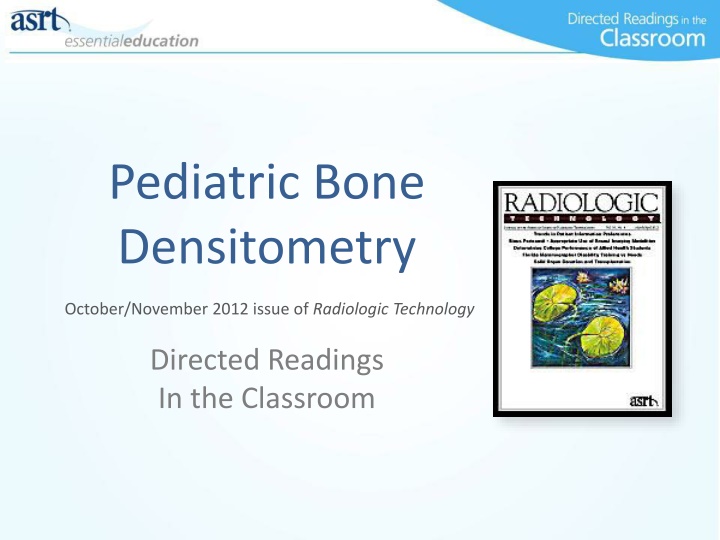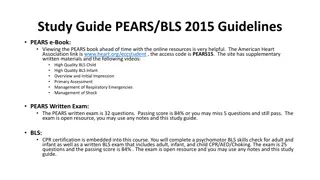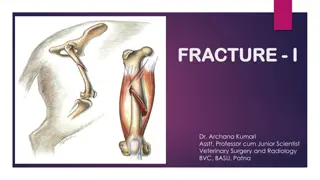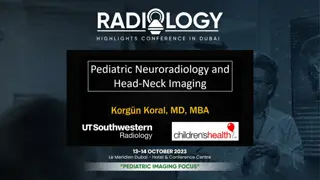Pediatric Bone Health: Imaging and Assessment in Children
Discussions on the importance of assessing bone density in pediatric patients, focusing on skeletal development, anatomy, and types of bone tissue. Exploring how bone densitometry can help identify diseases affecting bone growth in children and adolescents to prevent future complications like osteoporosis and fractures.
Download Presentation

Please find below an Image/Link to download the presentation.
The content on the website is provided AS IS for your information and personal use only. It may not be sold, licensed, or shared on other websites without obtaining consent from the author.If you encounter any issues during the download, it is possible that the publisher has removed the file from their server.
You are allowed to download the files provided on this website for personal or commercial use, subject to the condition that they are used lawfully. All files are the property of their respective owners.
The content on the website is provided AS IS for your information and personal use only. It may not be sold, licensed, or shared on other websites without obtaining consent from the author.
E N D
Presentation Transcript
Pediatric Bone Densitometry October/November 2012 issue of Radiologic Technology Directed Readings In the Classroom
Instructions: This presentation provides a framework for educators and students to use Directed Reading content published in Radiologic Technology. This information should be modified to: 1. Meet the educational level of the audience. 2. Highlight the points in an instructor s discussion or presentation. The images are provided to enhance the learning experience and should not be reproduced for other purposes.
Introduction Discussions regarding bone density typically focus on postmenopausal women, osteoporosis, and fracture risk. Although these are the most common reasons patients have skeletal strength assessments, the use of bone densitometry and bone mineral density measurement in pediatric patients is becoming increasingly valuable to assess children with diseases that cause inadequate bone growth. This article discusses pediatric bone disease and current and emerging imaging options for assessing bone density in children and adolescents.
Pediatric Skeletal Development Adolescence is a period of rapid development and a critical step toward building adult skeletal strength. During childhood and adolescent years, the skeleton accumulates bone mass and generally reaches a peak level of bone strength in late adolescence. If factors prevent a teenager s skeleton from growing and strengthening during this time, his or her adult skeleton will not reach an adequate level of bone mass and the risk for adult osteoporosis and fracture increases.
Skeletal Anatomy The human skeleton is made up of long, short, flat, and irregular bones. Typical long bones include the humerus, radius, and ulna. Short bones include the carpal and tarsal bones, which form the wrists and ankles. Flat bones make up the bony structures of the skull, and irregular bones include the vertebrae.
Skeletal Anatomy There are 2 types of bone tissue in the human skeleton: cortical (compact) bone and trabecular (spongy or cancellous) bone. Cortical bone includes tightly packed haversian systems, or osteons, each of which contains a central haversian canal surrounded by rings of bony matrix. Within these rings of bony matrix are mature bone cells (osteocytes) in spaces called lacunae. These systems include small canals called canaliculi that allow blood vessels to pass through the tightly packed hard matrix. Trabecular bone is softer and less dense than cortical bone. Individual plates called trabeculae align around irregular cavities that provide space for red bone marrow.
Normal Skeletal Development Osteogenesis and ossification are terms that describe bone formation and growth. Bones formed using intramembranous ossification include the flat bones of the skull and a small number of irregular bones known as intramembranous bones. The other bones of the skeleton are formed by endochondral ossification, which replaces hyaline cartilage with bony tissue. During fetal development the skeletal pattern is formed into a model made of cartilage. Endochondral ossification begins about 12 weeks after conception and the hyaline cartilage model begins to change into bone.
Normal Skeletal Development The long bones grow in length using specialized bone cells called prechondrocytes in the epiphyseal (growth) plates. The prechondrocytes separate into groups of proliferative and then hypertrophic chondrocytes. Chondrocytes are tiny cells that produce the components of cartilage. Prechondrocytes are resting cells that line up in the epiphyseal plate. They are critical to orienting the bone- making cells and providing unidirectional bone growth. During the proliferative phase, the chondrocytes divide, which creates more bone cells, and synthesize.
Normal Skeletal Development When the chondrocytes synthesize, they excrete bony matrix proteins. These cells then reach a limit in their ability to replicate and become hypertrophic. At this phase the cells become larger, have a round appearance, and increase in calcium concentration, which causes mineralization. The epiphysis continues to grow cartilage using mitosis, and osteoblasts form bone in this area by ossifying the matrix. This process continues from age 20 to about 25 years, when the epiphyseal plate completely ossifies and bone lengths reach their maximum.
Normal Skeletal Development The overall skeleton increases in size through a series of bone modeling and remodeling. Modeling increases bone width as new bone forms on the outer or periosteal surface. At the same time, remodeling also occurs as the inside endosteal surface of the bone is reabsorbed. This type of bone development is called appositional growth. Osteoblasts form new bone cells around the outer surface of the bone, increasing its size and strength. On the inside of the bone, osteoclasts remove bone cells by breaking them down. This method allows the bone to grow in width, while also limiting buildup of bone cells in the endosteum and reducing bone weight.
Wolff Law Factors that influence the cycle of bone growth include physical activity level, genetics, and response to loading from gains in body weight. The final size and shape of the bone follows Wolff law. This theory, established by German surgeon Julius Wolff, states that under normal conditions, a healthy person s bone adapts to the loads placed upon it. There is evidence that the converse also is true: When loads placed upon bones decrease, there are fewer stimuli for remodeling and the bones become weaker over time. The required bone mass is not maintained and the reduced skeletal strength can increase risk for fracture.
Bone Mineral Density Bone mineral density (BMD) is valuable in determining bone strength. Pediatric patients bone density most often is measured using DXA and expressed by Z-score, which measures standard deviations from norms for peerbased populations.
Abnormal Skeletal Development Treatmenting adolescents at risk of decreased BMD presents many difficulties for clinicians. Current research indicates that many factors eg, chronic illness, poor diet, illnesses or injuries that cause immobilization, and certain genetic or hormonal disorders, place adolescents at risk for skeletal weakness.
Weight-bearing Activity Many studies have shown the effects that immobilization and lack of skeletal loading have on skeletal strength. Physical activity, along with the frequency and degree of weight bearing, affect the development and strengthening of the adolescent skeleton and could affect an individual s risk for osteoporosis and fracture as an adult. When children and adolescents have conditions or injuries that cause lengthy immobilization, their skeletons might not develop adequately. Certain neurological conditions cause immobilization and put pediatric patients at risk for poor skeletal development.
Nutrition Another important player in the development of healthy, strong bones is nutritional status. A lack of important nutrients such as calcium and vitamin D can prevent a young person s skeleton from developing peak bone mass and affect skeletal strength in adult life. Poor nutrition or malnutrition can be caused by socioeconomic and cultural factors, as well as gastrointestinal disorders such as lactose intolerance, inflammatory bowel disease, or celiac disease. Children who have lactose intolerance often have decreased calcium intake, and the bodies of children who have celiac disease do not properly use the calcium the children ingest. If left untreated, these dietary deficiencies result in low BMD.
Nutrition Calcium intake during adolescence plays a vital role in skeletal development. Adequate calcium levels can improve the rate of bone turnover and increase the size of remodeling space, thus increasing BMD. Calcium absorption increases during puberty, and children should have a minimum of 1300 mg per day to maintain skeletal health.
Musculoskeletal Disorders Children and adolescents who have primary or secondary musculoskeletal disorders are at higher risk for having a weakened skeleton and possibly for fracture. Disorders that affect the strength of muscles and connective tissues might limit the amount of mechanical stresses that can be applied to a patient s bones. As a result, remodeling may not be sufficiently induced and normal mineralization might not occur.
Musculoskeletal Disorders Musculoskeletal diseases also cause children to be immobile or less active. Children with juvenile rheumatoid arthritis have been noted to have reduced BMD and increased fracture risk. Other musculoskeletal disorders that might lead to low bone density in pediatric patients include muscular dystrophy, osteogenesis imperfecta, spina bifida, dermatomyositis, scoliosis, and idiopathic juvenile osteoporosis. Primary care providers should monitor the skeletal strength of children and adolescents with these disorders. Technologists and radiologists also must be aware of the skeletal effects of these disorders, and scanning protocols may need to be modified to gather accurate BMD measurements.
Hormonal Status Multiple hormones affect bone formation during adolescence. Studies have found that patients who have decreased hormonal status have lower levels of BMD compared with healthy people. Hormone levels that are either too high or too low can have a negative effect on bone formation or may cause increased levels of bone absorption during remodeling. In particular, growth hormone plays a major role in bone development. During puberty, having low levels of growth hormone limits bone mineral accrual. Studies show that patients with low growth hormone levels have low BMD compared with people in control groups.
Hormonal Status Reproductive hormones also are important during adolescent bone development. Estrogen has been shown to have protective qualities that ward off bone loss and osteoporosis in postmenopausal women. effect from estrogen has been found in adolescent girls who take oral contraceptives. The low estrogen levels in oral contraceptives are associated with reduced BMD when the medication is taken during skeletal development. Health care providers who prescribe oral contraceptives during an adolescent s skeletal development should take mineral accrual into account, and when needed, measure BMD.
Chronic Medical Conditions Many chronic medical conditions can affect peak bone mass development and increase a person s risk for fracture. These conditions also may increase the risk of osteoporosis in adulthood. Diseases of specific organs or systems, including liver and kidney disease, affect the absorption of necessary vitamins and minerals. Liver disease can be linked to reduced skeletal development caused by limitations on vitamin D activation and effective absorption of calcium.
Chronic Medical Conditions Asthma also can negatively affect bone development. One reason is that having asthma can reduce a young person s ability to participate in adequate levels of weight-bearing exercise. Adolescents who have asthma also can have chronic hypoxia, which might not allow for normal bone metabolism. Many blood disorders, including chronic anemia, hemophilia, and sickle cell anemia can affect bone strength and structure. All of these blood conditions can reduce a child s or adolescent s physical activity and resulting skeletal loading, thereby preventing peak bone mass from being reached.
Chronic Medical Conditions Various types of childhood cancer also play a role in the development of peak bone mass. Leukemias are the most common types of malignancy among children, and acute lymphocytic leukemia is the most common leukemia in children. The treatment can correlate with low BMD up to 20 years following treatment. Chemotherapy medications, including high-dose methotrexate, are believed to adversely affect BMD.
Pediatric Skeletal Health Assessment The selection of appropriate protocols for measuring BMD in pediatric patients is important to reduce radiation risk and ensure that images and information are of diagnostic quality. Clinicians must determine whether the benefits of BMD measurement for a child or adolescent outweigh risk from radiation. The optimal method for BMD measurement must be determined based on estimated radiation dose and reports of efficacy in the pediatric population.
Methods DXA is the most common method of evaluating BMD in adult populations. Other methods for measuring BMD include quantitative ultrasound (QUS) imaging and peripheral quantitative computed tomography (pQCT). Each method has advantages and disadvantages that factor into the clinician s decision.
How DXA Works DXA uses 2 levels of x-ray photon energy to measure the amount of minerals in bone. The difference in attenuation of the x-rays by bone generates 2-D measurements of bone mineral content in grams and areal BMD. DXA x-rays are produced with a fan beam or a pencil beam. Pencil-beam equipment uses small, angled x-ray beams that move across the patient in a linear direction. The fan-beam generators use a wider beam that reduces scan times but increases radiation dose to patients. The choice between fan-beam and pencil-beam technology is an important consideration when a radiology department develops protocols or purchases equipment for pediatric bone densitometry.
How DXA Works Automated simulation of areal bone mineral density (BMD) assessment in the distal radius from high-resolution peripheral quantitative computed tomography (pQCT).
How DXA Works DXA uses 2 levels of x-ray photon energy to measure the amount of minerals in bone. The difference in attenuation of the x-rays by bone generates 2-D measurements of bone mineral content in grams and areal BMD. DXA x-rays are produced with a fan beam or a pencil beam. Pencil-beam equipment uses small, angled x-ray beams that move across the patient in a linear direction. The fan-beam generators use a wider beam that reduces scan times but increases radiation dose to patients. The choice between fan-beam and pencil-beam technology is an important consideration when a radiology department develops protocols or purchases equipment for pediatric bone densitometry.
How DXA Works Magnification also is a concern with fan-beam DXA scanners. The child s body thickness can increase object-to- image receptor distance (OID) and size distortion on the resulting image. DXA equipment is designed for use with adults, and its algorithms for OID are based on an average- sized adult. This makes the development of scanning protocols and interpretation for pediatric DXA difficult. With standard equipment, the radiologist must compensate for the differences between adults and children. The measurement of BMD is in 2 dimensions, and the measurement can be overstated for larger subjects and understated for small children.
How DXA Works Developing children are sensitive to radiation dose and the principles of ALARA always must be followed. DXA uses a relatively low radiation dose to accurately measure BMD. For pediatric DXA, the pre-imaging questionnaire must provide a detailed patient history; different protocols might be necessary depending on a patient s risk factors. BMD measurements of several areas of the body can be made including the hip, lumbar spine, and distal radius. The hip is the most commonly measured area.
Advantages of DXA A main advantage of DXA for use with pediatric patients is the relatively low radiation exposure. With use of appropriate pediatric scanning parameters, the dose from DXA is less than 0.013 mSv,4 well below the yearly exposure rate of 5 mSv that the National Council for Radiation Protection recommends as an exposure limit for pediatric medical procedures. The radiation exposure from a pediatric whole body scan is comparable to the exposure from a coast-to-coast U.S. flight. Relatively low radiation exposure makes DXA an advantageous choice for BMD measurement of pediatric patients and likely contributes to its widespread use.
Advantages of DXA Another advantage of DXA is its availability. Because DXA is used to assess BMD and diagnose osteoporosis in postmenopausal women, the equipment is located in many geographical areas. For this reason, equipment is available for measurement of BMD in children and adolescents without causing onerous driving times for parents or scheduling delays caused by limited access to specialized pediatric BMD measurement equipment.
Advantages of DXA The scan time for DXA typically lasts less than 3 minutes for pediatric protocols.4 The DXA s shorter scan time is advantageous because the radiology department can be intimidating for pediatric patients and long scan times might add to patients anxiety. In addition, DXA scans can be performed without the patient needing to change into a gown, as long as no metal covers the scan field. Wearing their own clothes makes the modality more comfortable for pediatric patients who might feel shy.
Disadvantages of DXA DXA has some disadvantages as a method for measuring BMD in pediatric patients. The measurement provided by DXA scanners is a 2-D representation of areal BMD. A DXA measurement is not a true volumetric evaluation of the BMD. For this reason, DXA accuracy may be affected by the actual size of the measured area. Children develop and grow differently, making compilation of an age-based reference database for comparison difficult. A developmental age- based comparison may be more accurate and provide an appropriate comparison.
Disadvantages of DXA Pediatric patients who require BMD measurement can have certain disease risk factors, which also affect the developmental size of their skeleton. This information must be considered by the technologist and interpreting radiologist to ensure the measurement and comparison information provide accurate results. DXA cannot distinguish between cortical and trabecular bone. This makes it impossible to measure the changes in the patient s skeletal structure that are taking place during puberty. The changes occurring during adolescence play a role in the strength of the bone, and may help to indicate which patients are at increased risk for fracture.
Quantitative Computed Tomography Computed tomography (CT) can be used to quantitatively measure the strength of the pediatric skeleton. QCT is considered the preferred method for noninvasive evaluation of bone strength, BMD, and bone mineral content. Additional software is required to measure BMD with a standard CT scanner. The software contains algorithms and protocols designed to measure volumetric BMD. BMD measurement software is not standard on CT scanners and must be purchased separately for a relatively high cost.
How QCT Works The volumetric BMD measurement is reported in grams/cm3 and is not affected by patient size. With these measurements, the QCT system can calculate multiple other factors that indicate bone strength. The size and geometric factors of bone can be assessed, which provides the interpreting radiologist additional information regarding the patient s bone strength. The QCT scan can show the patient s periosteal and endosteal circumferences, along with the actual cortical area and thickness. Cortical BMD can be accurately measured at distal radius sites using peripheral QCT (pQCT).
How QCT Works Specifically, the pQCT scan can provide measurements of cortical bone area, trabecular bone area, cortical thickness, and periosteal/endosteal circumferences. Using this information, the pQCT software then can calculate the cortical and trabecular volumetric BMD, along with other measurements of bone strength, including polar moment of inertia and polar strength-strain index.
Cortical pQCT Cortical bone measurement using pQCT. Patient in A has significant reduction of cortical bone volume when compared with a healthy control (B).
How QCT Works A QCT system is unable to accurately image cortical bone that is less than 2 mm in size, which results in reduced spatial resolution and underestimation of the volumetric BMD. When the area of cortical bone is less than 2 mm, a partial volume effect can interfere with the computations generating the measurements.
How QCT Works QCT measurements are difficult to perform serially in pediatric patients because of the changing size and shape of the bones during growth. In addition, patient movement between scans, or between the scout image and scan, can interfere with imaging accuracy. Technologists need to consider this when imaging pediatric patients who are unable to remain still or are less able to understand and follow instructions.
pQCT Images Images A and B show pQCT images through the distal radius of 2 patients with substantial differences in trabecular and cortical structure. The 2 patients have identical BMD measurements in this region using dual-energy x-ray absorptiometry. Images C and D depict 3-D reconstructions of the cortical and trabecular bone compartments. Red areas depict porosity of the cortical bone.
Use of QCT for Pediatric Patients QCT and pQCT create true volumetric data sets by measuring the bone in 3 dimensions, while DXA provides 2- D measurement. The use of CT for the measurement of BMD and skeletal strength has many advantages that are somewhat outweighed by a higher radiation dose. This is an important factor when considering the pediatric patient s sensitivity to ionizing radiation and the potential for increased cancer risk. QCT also can help differentiate between cortical and trabecular bone. The differentiation allows the radiologist to track the true changes in the size and shape of bone that occur during puberty, which can aid in diagnosis
Use of QCT for Pediatric Patients A drawback of QCT for pediatric patients is that the modality requires use of more radiation than does DXA. A QCT examination using a low-dose protocol is associated with a radiation exposure of approximately 0.03 mSv to 0.3 mSv.60 Although the dose still is well below the recommended annual dose of 5 mSv, radiographers and other health care providers must consider the fact that pediatric patients requiring BMD measurement most likely have medical conditions that require other imaging examinations. The combination of additional radiographic examinations and QCT skeletal assessment can contribute to a patient s cumulative radiation exposure.
Quantitative Ultrasound QUS uses sound waves traveling through bone to measure how the signal strength is attenuated by the structure. Because ultrasonography uses no ionizing radiation, it has excellent potential for use in measuring skeletal development in pediatric patients.
How Quantitative Ultrasound Works QUS reports the strength of bone as speed of sound or broadband ultrasound attenuation. Speed of sound measures the strength and elastic modulus of bone using a ratio of distance to travel time for the sound waves produced by the transducer as the waves move through the skeletal site being imaged. The speed of sound measurement can indicate the stiffness of a substance, which in this case would be the bone of a child or adolescent. The broadband ultrasound attenuation measures how much energy of the sound wave is lost from bone attenuation. The information can be used to measure the bone s physical properties, including bone density, and results appear to be comparable to DXA in accuracy for adult patients.
QUS in the Pediatric Population The developing bodies of children and adolescents are sensitive to the effects of ionizing radiation. For this reason, ultrasonography can be extremely useful as a skeletal strength measurement technique for pediatric patients. Additionally, QUS is portable, less expensive than DXA or QCT, and has the potential to provide rapid office-based BMD measurement.57 The QUS measurements can be taken using a portable scanner, which is convenient for the radiology department.
QUS in the Pediatric Population Many studies have compared results of QUS measurements with DXA and QCT measurements of BMD. Some studies suggest that QUS results correlate with BMD, but other studies state that QUS findings do not correlate with BMD measurement. For this reason QUS is not used for pediatric diagnosis of low BMD in the United States. With increased research and development of pediatric-specific QUS imaging devices, this modality could become a common choice for pediatric skeletal assessment.
QUS in the Pediatric Population At this point, use of QUS for BMD measurement in pediatric patients is not widely accepted. Standard ultrasound imaging equipment is manufactured with transducer sizes for adult patients that will not work for pediatric patients. Inadequate data exists to develop effective comparison populations for children. This method for BMD measurement needs further research and development of technical reference and comparison databases. In the future, QUS might become a more viable option for evaluating the skeletal health of pediatric patients.
Use of BMD in Pediatric Patients Before using pediatric BMD measurement, the radiologist, technologist, and referring clinician need to understand the protocols and procedure to ensure that accurate results and patient safety are obtained. For pediatricians, the goal of BMD measurement is to successfully identify patients at risk for low bone density and fracture to decide whether treatment for low BMD is necessary. BMD also is used to monitor the successes or failure of an intervention when patients require treatment.























